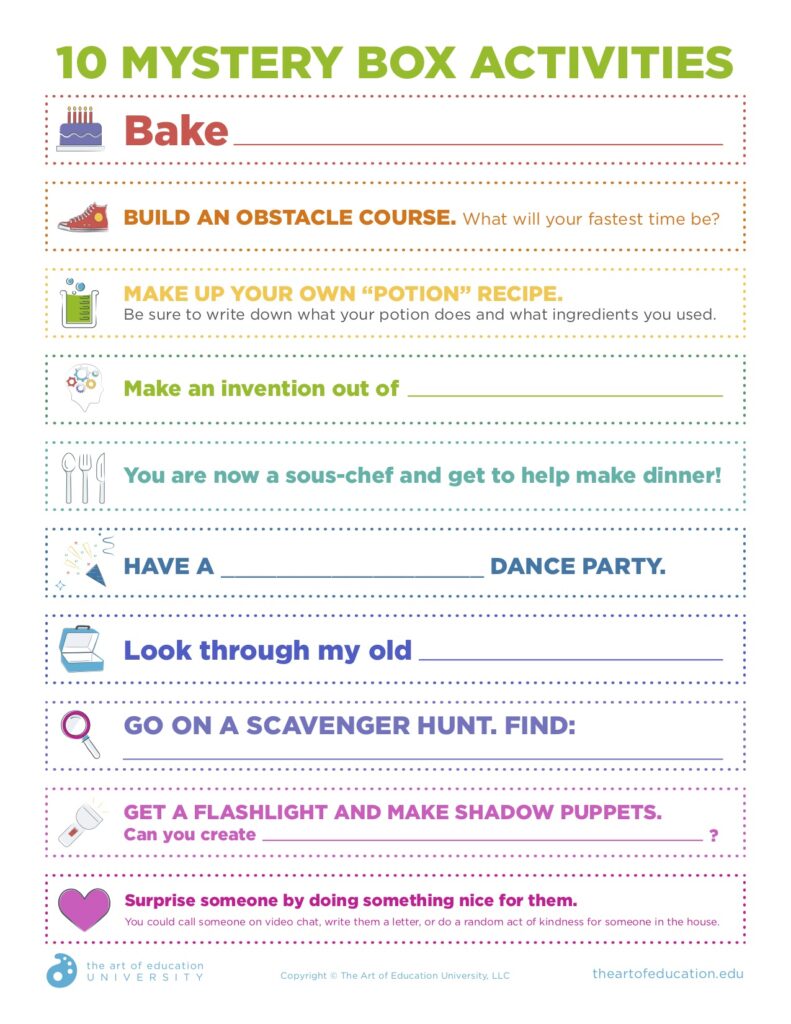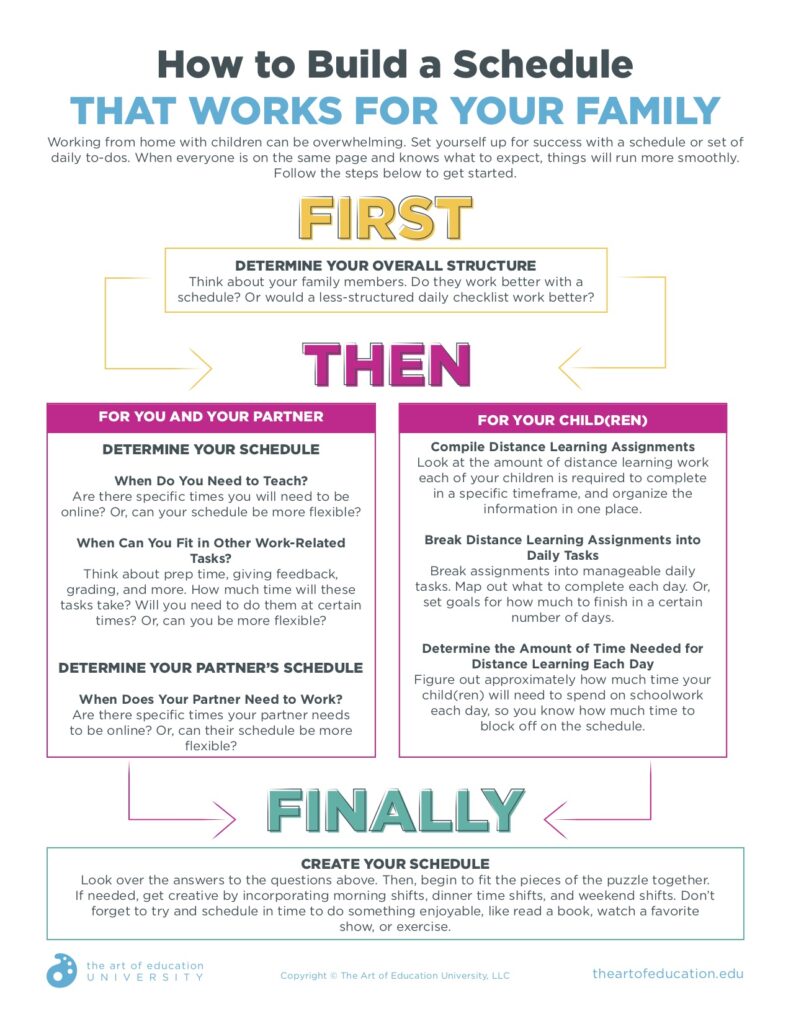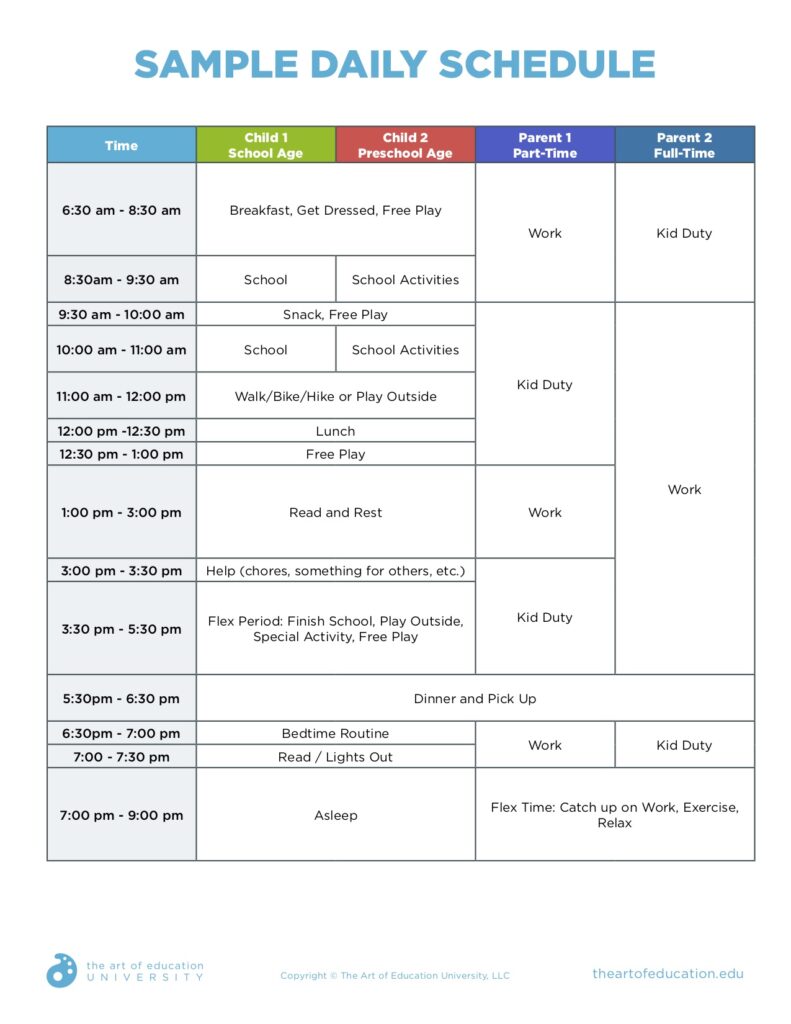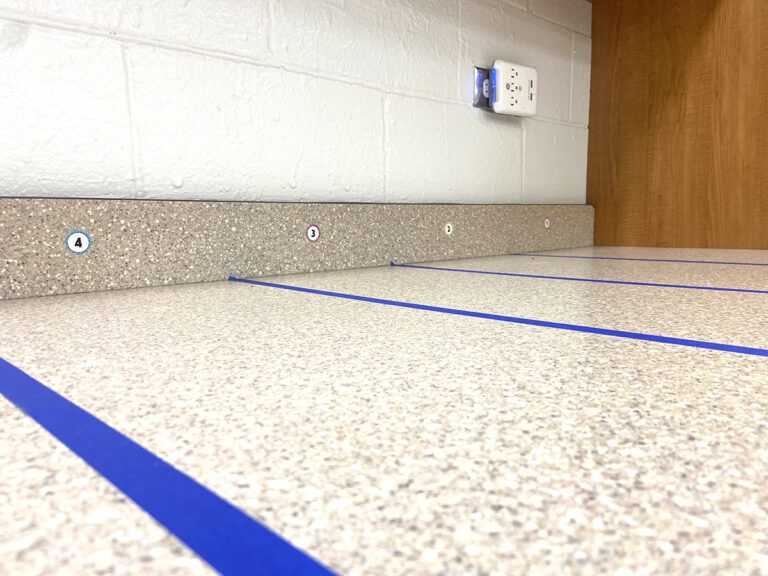Art Education and the Coronavirus (COVID-19)
Teaching from home long-term is no picnic. You don’t have access to your classroom, supplies, and most importantly, your students! With the advances in technology, solving these problems is doable. You can set up Google Classroom, meet with students via Zoom, and get creative with your supplies.
However, there’s one thing about working from home that technology can’t easily solve. How do you teach from home while also caring for your family?
Sure, you can put on an educational show once in a while. But when everyone is home for an extended period of time, you need solutions that last. Although they’re not always the most fun thing to talk about, the logistics of your situation can make or break your time at home.
Let’s look at 5 ways to manage teaching from home when you have a family.

1. Maintain your regular routines.
Getting up early, exercising, and getting dressed may seem like the last things you want to do right now. However, research shows keeping regular routines can be beneficial for your mental health. Routines let everyone know what to expect and can maintain a sense of normalcy.
Let’s say you usually get up at 6 am, take a shower, and have coffee, before heading to school. Try and continue this routine even though you don’t have to rush out the door. Or, maybe, your kids are used to eating breakfast, lunch, and dinner at certain times. Staying on track with mealtime can help their bodies as they adjust to a new school schedule.
The same goes for the end of the day. Keeping bedtime routines consistent will help everyone feel well-rested and ready to tackle what the days ahead bring.
2. Carve out workspaces for all of your family members.
Finding space for everyone to work during extended closures is kind of like creating a seating chart for your classroom. What does everyone need to work on? Do they need special accommodations? How easily do they get distracted, and what can you do about it? How are you going to handle the noise?
If you have school-age kids, this is a perfect topic for a family meeting. Involving your kids in solving the problem will help them feel a sense of ownership. They may even choose to decorate their designated workspaces in personal ways.
Let’s say you have two parents working from home along with a school-age child and a preschool-age child. How can you meet everyone’s needs? Maybe you designate a quiet space for the parents to share. If you’re teaching from home and hosting video meetings, make sure you choose a space with a neutral background.
Older children may be able to handle working in their bedrooms. Or, you may decide it’s best for them to be in a communal area so you can keep an eye on them. Young children will need a spot to play safely within sight as well. Depending on the age of the child, you might consider getting creative with baby gates or play yards to create a designated space they can safely explore.
Finally, think about noise. If you live in a smaller home or apartment, it may be worth investing in earplugs or noise-canceling headphones.
3. Create and stick to a schedule.
Perhaps the most important thing you can do while everyone is home is to create a schedule. This goes back to the idea of routines being comforting in times of uncertainty.
Here are 3 main reasons for creating a family schedule.
1. It keeps everyone on the same page.
Just like in a classroom setting, when expectations are clear at home, things run more smoothly. It allows everyone to see what the day will look like at a glance as well as their specific responsibilities.
2. It breaks up the day.
When working from home for an extended time, days can start to feel long. With a schedule, there are clear, defined sections of the day. This delineation helps the day go more quickly.
3. It keeps everyone on track.
Having a schedule allows you to have focused times to work. This is important because staying on task when you aren’t in your normal work environment can be tricky. By nature, this also means the schedule includes designated time to relax and recharge. Building in time to rest is essential for making it through an extended work-from-home situation.
Now that we know why having a schedule is important, let’s look at how to create one.
In order to create a schedule, you need to carve out some time to think through things. If you need help finding the motivation to do this activity, think of it like prep time. You can absolutely go into a classroom, wing it, and be OK. But when you have a solid plan, the lesson goes so much more smoothly. This situation is no different.
Download this handy guide and read the steps below.
Step 1: Determine your overall structure.
The first thing you’ll want to do is figure out which method will work best for your family. Do people work best with a checklist to complete by the end of the day? Or, do they work better when they have a specific set of tasks to complete at specific times? Once you’ve figured this out, you can move on to step two.
Step 2: Nail down each family member’s weekly responsibilities.
Next, it’s time to figure out what each family member has to do each week.
To do this, answer the questions below for yourself and your partner.
- Are there specific times you need to be online? Or, can your schedule be more flexible?
- How many hours do you need to work each week?
Then, answer the following questions for your children.
- How much distance learning work will they have each week? How does this translate into time spent daily?
- Are there specific times they need to be online each week?
Step 3: Create your schedule.
Once you’ve answered the questions in steps one and two, you’re ready to draft your schedule. First, block off all of the non-negotiable times. These would include times you have to be teaching, times your partner has to be working, and times your children have to be online.
From there, you’ll need to get creative. If one parent has a more flexible schedule, they may need to work early mornings, nights, or weekends. To help offset this after-hours work, the other partner may take on more childcare responsibilities during those times.
For kids, consider keeping their school schedule the same. For example, if they normally have math Monday, Wednesday, Friday, and music on Tuesdays, attend to those subjects on those same days.
Make sure to build in some time for relaxation and fun, too!
You can see a sample schedule below. This outlines what a day might look like for two working parents, a school-age child, and a preschool-age child.
4. Keep the lines of communication open.
As you might be able to gather, getting a system in place is no easy task. This is why communication is key.
Here are 3 ways to keep the lines of communication open during this time.
1. Post your schedule.
Once you’ve created your schedule, make sure you post it so that everyone can read it. If you have younger children at home, you may want to include visual cues as well. Remember, your schedule may have to change from day-to-day. Make sure to keep an updated copy on-hand. Consider creating your schedule each day on an erasable surface like a chalkboard, whiteboard, or even a sliding glass door!
2. Start every day with a morning meeting.
Morning meetings are often used in preschool and elementary classrooms as a way to set the tone for the day. While you don’t need to talk about what the weather will be like, setting five minutes aside to go over the daily schedule is a great idea!
Things to hit in a morning meeting include:
- Date/day of the week
- Important upcoming schoolwork deadlines
- Daily schedule, including schoolwork times and rest times
- Special activities
- Which parent is working at which time
3. Frequently check in with each other.
Extended school closings can be hard on everyone. Frequently check in with your partner to make sure you’re on the same page about work schedules, childcare, and household responsibilities. In the same way, check in with your kids. How are they holding up? What’s worrying them? Is there anything that would make their time at home easier? Having these honest conversations will help keep frustrations from building up.
Learn more here!
5. Build-in time for fun and relaxation.
Make sure you build in time to have fun and relax. Because time can be so precious in a situation like this, it’s important to write everything down. Otherwise, you may fill free pockets of time with more work or household responsibilities.
With children, you also may want to have some fun, novel activities you can pull out when you need a moment of peace and quiet. Have them go through your old rock collection, call a grandparent, or do a special project.
One specific idea is to create a “Mystery Box” with daily prompts. You can pull these prompts out at a moment’s notice when you need some peace or something to fill the time. You can find a download with ten ideas to get you started below.

Working from home is no easy task. You shouldn’t expect to figure everything out right away. Be sure to give yourself some grace and time as you work through your new realities with your family. Developing a schedule early on can help set the tone. But, don’t feel like you have to do everything all at once! As time goes by, you’ll naturally fall into a routine that works for you.
What’s been the most difficult thing about a long school closure for you?
Do you have any other tips and tricks to share?
Magazine articles and podcasts are opinions of professional education contributors and do not necessarily represent the position of the Art of Education University (AOEU) or its academic offerings. Contributors use terms in the way they are most often talked about in the scope of their educational experiences.







